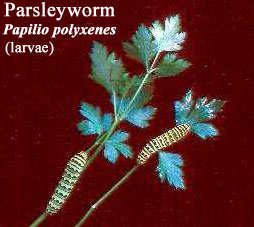Parsley (Petroselinum)
Plant Health Problems
Parsley belongs to the same family as celery and can be susceptible to many of the same diseases. See Celery for a detailed discussion of these diseases.
Diseases caused by Fungi:
Root and crown rot, Rhizoctonia solani, Pythium spp., Fusarium spp.
Symptoms appear as wilting and a slow or rapid collapse of the plant. The roots can appear brown and water-soaked instead of white. A water-soaked lesion can often appear at the base of the stem.
Control can be achieved by using a two-year rotation with nonsusceptible plants, such as corn, to prevent the buildup of pathogenic organisms.
Leaf blight, Septoria spp.
This disease appears as small, tan leaf spots with black dots across the surface of the spots. These spots may grow together and kill the leaflets or leaves. The fungus which causes this disease is closely related to the fungus responsible for late blight of celery.
The disease is not very important on parsley in Connecticut, and control measures are not usually required.
Botrytis blight, Botrytis cinerea.
Botrytis blight occurs on many different kinds of herbs. The disease appears when plants are grown under conditions of high humidity, such as in a terrarium. The disease appears as tan to brown spots on leaves that can be associated with a grayish mold colonizing the damaged area.
Botrytis blight can be suppressed by avoiding overhead irrigation and watering in the morning to allow time for leaves and flowers to dry. Proper plant spacing can improve air drainage and rapid leaf drying. Control can also be achieved with the use of fungicide sprays applied as soon as symptoms are visible. Among the compounds registered for use in Connecticut are copper hydroxide and thiophanate-methyl. Consult the label for dosage rates, safety precautions, and indoor use.
Diseases caused by Physiological/Environmental Factors:
Cold water injury, cold water used for watering.
When parsley is grown indoors, irregular or ring-like pale tan spots appear on the upper side of the leaves. Injury occurs when water which is colder than the surface of the leaf is used for watering. Symptoms are often more pronounced during the winter months.
This problem can be avoided by watering with tepid or room-temperature water and by not wetting the foliage during watering.
Soluble salt injury, excessive fertilization and accumulation of high levels of soluble salts in potting medium.
When herbs are grown indoors, they can develop root injury from excessive levels of fertilizer in the potting medium. Symptoms are similar to those caused by root rot so analysis of the soil is required for correct diagnosis. An indication of high soluble salts is the presence of white crystalline deposits on the rim of the outer surface of the pot or on the surface of the potting medium.
Soluble salts can sometimes be leached from the potting mix by running a stream of water through the soil for approximately 20 minutes. However, when salt levels are excessive, the plant can be repotted into fresh sterile potting mix and a clean pot. It is also important to avoid excessive use of fertilizer during periods of slow growth.
Insect Problems:
Aphids.
Aphids may occasionally feed on parsley. See Aphid fact sheet.
 Black swallowtail or Parsleyworm, Papilio polyxenes.
Black swallowtail or Parsleyworm, Papilio polyxenes.
This colorful caterpillar is occasionally found on carrot, parsley, dill, fennel, celery, and other cultivated or wild members of the carrot family. The caterpillars are about 2" long when fully grown, and green with a yellow-spotted black crossband on each segment. The adult is the common large black swallowtail butterfly with a wingspread of almost 4". It has two nearly parallel rows of yellow spots on the outer margins of the wings and other light blue areas on the rear wings. This insect overwinters as a tan chrysalis and there are two generations each year. They rarely require control other than hand picking.
Parsley stalk weevil, Listronotus latiusculus.
The fat, white, legless grubs of this weevil sometimes tunnel in the main stem of parsley. Control has not been necessary.

